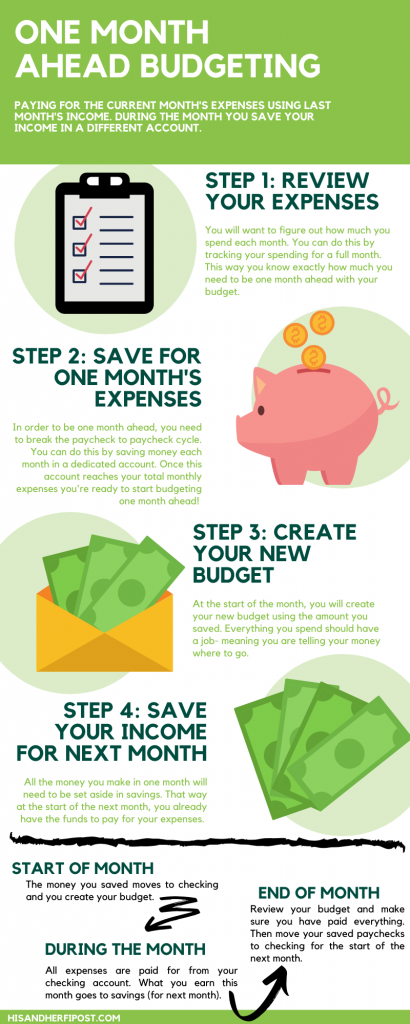Living paycheck to paycheck is a regular occurrence for many Americans. That’s why I’m going to tackle the question of how to stop living paycheck to paycheck and share how we got one month ahead of our bills.
What Does It Mean to Live Paycheck to Paycheck?
Living paycheck to paycheck means your monthly income is devoted to expenses with little to nothing left over for saving or paying off debt.
It’s a cycle that can be very difficult to get out of. Each month your money comes in and goes out without progress towards financial stability or wealth building.
It should be mentioned that your socioeconomic status, race, and gender can all present additional barriers to breaking the paycheck to paycheck cycle. It’s not all about your ‘financial perspective’ (although this does play a role). Systematic barriers are in place that make it even more challenging and I want to acknowledge that will make some of these steps less accessible- but not impossible.
How to Stop Living Paycheck to Paycheck
Before you try getting one full month ahead in your budgeting, it’s important to take the following steps so you can stop living paycheck to paycheck. After this, you can focus on getting one full month ahead in your budget.
1. Spend a little less than you make
The very first step to breaking the paycheck to paycheck cycle is to spend just a little bit less. It’s easy to let money slip out of your account with things like one-click Amazon purchases. Your goal should be to reduce the outflow of money. Below are a few ways that might help you spend a little less each month:
- Cancel all of your subscriptions
- Remove your credit cards from PayPal and online shopping platforms
- Consider cutting cable
- Join a free-cycle group or buy your items used
You may also be able to really cut back by downsizing. This could even be as big as a move to a cheaper area or home.
2. Create a budget
The word “budget” can carry feelings of being restricted and not spending. But I have found that the opposite is true. A budget can help you stop living paycheck to paycheck and spend where you want to. If you’re not into budget apps and spreadsheets make you cringe – then find a way to manage your money that covers the following steps:
- Identifying your income at the start of a pay period
- Identifying your expenses during that pay period
- Tracking all of your expenses
- Changeing based on your current financial needs
If you can do these 4 steps then you can have control over your money.
3. Pay off debt and avoid new debt
Debt can immediately reduce your income and keep you locked in living paycheck to paycheck. That’s because you not only need to pay for your essentials like food, shelter, and transportation- but you also need to pay a minimum on your debt.
First, you want to avoid taking on new debt. This means you don’t reach for the credit card when you are running low on funds. Instead, you choose to wait. (I know it’s hard!).
Next, as part of your budget or money management, you want to put a plan in place to pay off your debt. If you have not done this before there are two popular methods:
1. Debt Snowball
In this debt pay off method, you pay your lowest balances first. This way you get small wins along the way.
2. Debt Avalanche
In this debt pay off method, you pay your highest interest debt off first. This way you target the debt that is costing you the most. (This is how I am paying off my student loan debt.)
Both of these methods will work- but the debt avalanche does keep more money in your pocket by paying off high-interest first. In my opinion, the best way to pay off debt is the one that works for you and feels good.
4. Pay yourself first
By now you started spending less and are managing your money including debt. This is good, but you still want to think about one more financial necessity – saving. Saving money for an emergency should be your first priority. Then you can save to get one month ahead in your budget.
The best way to save money is to “pay yourself first”. When our paycheck comes in, we always make sure our food, shelter, bills, and debt payments are covered. Then we have an automatic withdrawal to separate savings accounts. This way we are paying our future selves before we spend on fun things or put more towards debt.
Set a “pay yourself first” savings plan in place. It doesn’t need to be $500- it can be as little as $20. Just start saving and you will be surprised how fast it builds (and how good you will feel with a little cushion).
5. Set your future financial goals
Living paycheck to paycheck puts you in a place of trying to get by month to month. But the future will soon be today and it’s important to plan for it. I want you to take a moment to think about your financial future (and dreams). Consider major expenses that might come up like:
- Retirement (the big one!)
- Having children
- Moving or buying a home
- Children going to college
- A dream vacation (because we all need to live a little)
Once you have these outlined, you can start to work them into your budget plans.
Budget by Paycheck with One Month Ahead Budgeting

The steps above will help you break the paycheck to paycheck cycle. To stop living paycheck to paycheck permanently you want to get one month ahead.
What is One Month Ahead Budgeting?
One month ahead budgeting means paying for the current month’s expenses using last month’s income. During the month you save your income in a different account.
How to Get One Month Ahead on Bills and Expenses
- You will want to figure out how much you spend each month. You can do this by tracking your spending for a full month. This way you know exactly how much you need to be one month ahead with your budget.
- You need to build a savings plan for your budget so you can get one month ahead. In order to be one month ahead, you need to break the paycheck to paycheck cycle. You can do this by saving money each month in a dedicated account. Once this account reaches your total monthly expenses you’re ready to start budgeting one month ahead! Some people can reach this quickly by:
- Using a bonus
- Selling a home and using the profits
- Saving their raise money
- Selling items or using a side income
- At the start of the month create your new budget. At the start of the month, you will create your new budget using the amount you saved. Everything you spend should have a job- meaning you are telling your money where to go.
- Save the income you make during the month. All the money you make in one month will need to be set aside in savings. That way at the start of the next month, you already have the funds to pay for your expenses.
No More Living Paycheck to Paycheck with This Budget
One month ahead budgeting creates a buffer so you do not need to live paycheck to paycheck anymore. Now that we are one month ahead we have a flow for our funds each month that looks like this:
- Transfer our paychecks in savings over to our checking
- Review our budget and upcoming monthly expenses
- Automatic savings comes out of the checking into various accounts
- During the month we track expenses
- During the month any income earned goes to savings (Paycheck deposits to savings automatically)
- At the end of the month, we review our budget and spending
- Repeat each month
To get one month ahead in our budget we saved for two months and used a bonus. Then we were able to start this process of one month ahead budgeting (and not live paycheck to paycheck).
Answering Your Questions about Living Paycheck to Paycheck
How many people live paycheck to paycheck?
Living paycheck to paycheck is common. According to a survey done by Career Builder, 78% of Americans live paycheck to paycheck.
GoBanking Rates 2019 survey results showed that 69% of Americans have less than $1000 in savings. The top reason for not saving more was living paycheck to paycheck.
How do I save when I live paycheck to paycheck?
Reduce your expenses. If you can cut even one thing- like a subscription- then you can save that money. The trick is making sure that the money you get back from cutting an expense is actually put away in savings.
I will also say that increasing your income with a side hustle or additional job can help you save and stop living paycheck to paycheck.
How much should I save per paycheck?
This depends on what your financial goals are. According to the most popular financial gurus the average individual should aim to save 20% of their paycheck. If you are on the path to financial independence then you’ll most likely be aiming for a savings rate of 50% or more.



